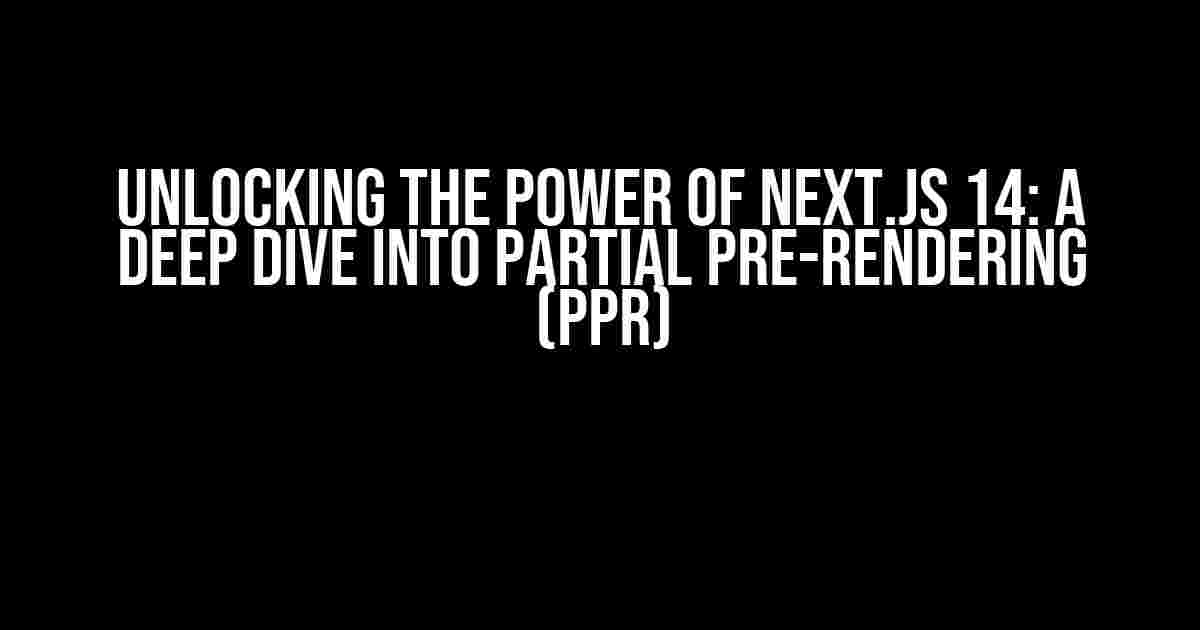Next.js, the popular React-based framework, has taken the web development world by storm with its innovative features and exceptional performance. With the release of Next.js 14, developers can now harness the power of Partial Pre-Rendering (PPR) to take their applications to the next level. In this article, we’ll delve into the world of PPR and uncover its secrets, providing you with a comprehensive guide to understanding and implementing this game-changing technology.
What is Partial Pre-Rendering (PPR)?
Partial Pre-Rendering is an innovative technique introduced in Next.js 14 that allows developers to pre-render specific components or sections of a page, rather than the entire page. This approach enables faster page loads, improved SEO, and enhanced user experience. PPR is particularly useful for complex applications with dynamic content, where full-page pre-rendering might not be feasible or efficient.
The Benefits of PPR
So, what makes PPR so special? Here are some of the key advantages:
- Faster Page Loads: By pre-rendering only the necessary components, PPR reduces the initial load time, resulting in a snappier user experience.
- Improved SEO: Search engines can crawl and index pre-rendered content, improving your application’s search engine ranking and visibility.
- Enhanced User Experience: PPR enables developers to provide a more seamless user experience by pre-loading critical content, reducing the perceived load time.
- Flexibility and Control: With PPR, developers have fine-grained control over what gets pre-rendered, allowing for more efficient use of resources.
How Does PPR Work in Next.js 14?
Next.js 14 introduces a new `getStaticProps` method that enables PPR. This method allows developers to define which components should be pre-rendered at build time. Here’s an example:
import { NextPage } from 'next';
import Head from 'next/head';
const Page = () => {
return (
<div>
<Head>
<title>My Page</title>
</Head>
<p>This content will be pre-rendered</p>
</div>
);
};
export async function getStaticProps() {
return {
props: {},
// Enable PPR for this component
partialPreRendering: true,
};
}
export default Page;
The Anatomy of getStaticProps
The `getStaticProps` method returns an object with three properties:
| Property | Description |
|---|---|
| props | An object containing the props for the component. |
| partialPreRendering | A boolean indicating whether to enable PPR for the component. |
| fallback | An optional boolean or string indicating whether to fall back to a static HTML file or a custom fallback page. |
Best Practices for Implementing PPR
Now that you know the basics of PPR, here are some best practices to keep in mind when implementing this technology:
- Choose Wisely: Only pre-render components that are critical to the user’s initial experience. Avoid pre-rendering unnecessary content to minimize build times and optimize performance.
- Optimize Your Code: Ensure that your code is optimized for PPR. Use techniques like code splitting, lazy loading, and memoization to reduce the payload and improve performance.
- Consider Fallbacks: Implement fallbacks for scenarios where PPR might not work as expected. This could include cases where the pre-rendered content is stale or inaccessible.
- Test Thoroughly: Extensively test your implementation to ensure that PPR is working as expected. Verify that pre-rendered content is loading correctly and that SEO is not compromised.
Troubleshooting Common PPR Issues
As with any new technology, you might encounter some issues when implementing PPR. Here are some common problems and their solutions:
| Issue | Solution |
|---|---|
| Pre-rendered content not showing up | Check that `partialPreRendering` is set to `true` and that the component is correctly exported. |
| Fallbacks not working as expected | Verify that the fallback is correctly configured and that the fallback page is accessible. |
| SEO issues due to PPR | Ensure that meta tags and other SEO-critical elements are correctly set in the pre-rendered content. |
Conclusion
Partial Pre-Rendering in Next.js 14 is a powerful feature that can significantly improve the performance and user experience of your applications. By following the best practices outlined in this article and understanding the inner workings of PPR, you’ll be well-equipped to unlock the full potential of this technology. Remember to test thoroughly, optimize your code, and consider fallbacks to ensure a seamless user experience.
Now, go ahead and take your Next.js applications to the next level with Partial Pre-Rendering!
Frequently Asked Question
Get ready to supercharge your Next.js app with Partial Pre-Rendering (PPR)! Here are some frequently asked questions to help you understand this game-changing feature.
What is Partial Pre-Rendering (PPR) in Next.js 14?
PPR is a new rendering mode in Next.js 14 that allows you to pre-render specific parts of your pages at build time, while deferring the rest to runtime. This hybrid approach combines the benefits of static site generation (SSG) and server-side rendering (SSR).
How does Partial Pre-Rendering differ from Static Site Generation (SSG)?
Unlike SSG, which pre-renders entire pages at build time, PPR focuses on pre-rendering specific components or sections of a page. This allows for more flexibility and optimization, especially for pages with dynamic or user-specific content.
What are the benefits of using Partial Pre-Rendering in Next.js 14?
PPR in Next.js 14 offers improved performance, faster page loads, and better SEO. By pre-rendering critical components, you can reduce the amount of work required at runtime, resulting in faster and more efficient page rendering.
Can I use Partial Pre-Rendering with Internationalization (i18n) in Next.js 14?
Yes! PPR in Next.js 14 is compatible with i18n. You can use the `getStaticProps` method to pre-render pages with translated content, ensuring that your internationalized pages are optimized for performance and SEO.
How do I get started with Partial Pre-Rendering in Next.js 14?
To start using PPR, simply update your Next.js project to version 14 and configure your `next.config.js` file to enable PPR. Then, use the `getStaticProps` method to define which components or sections of your pages should be pre-rendered at build time.






